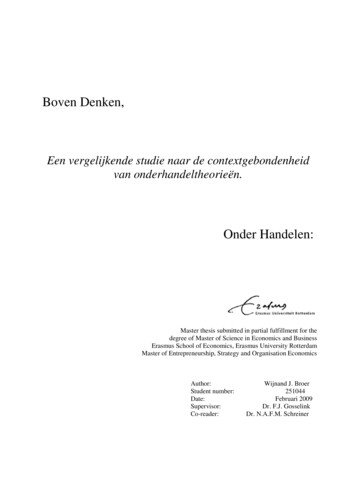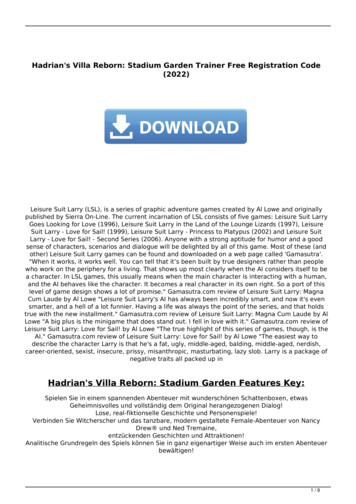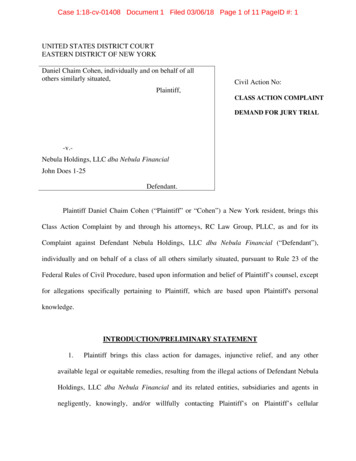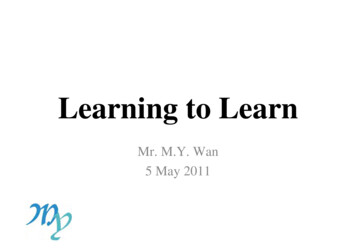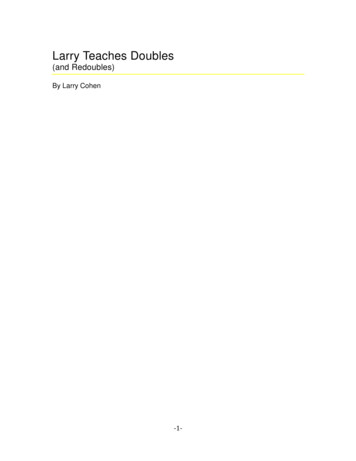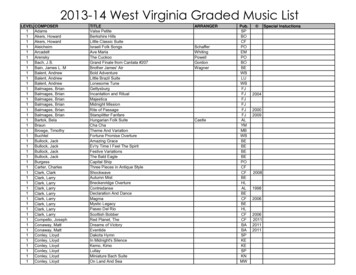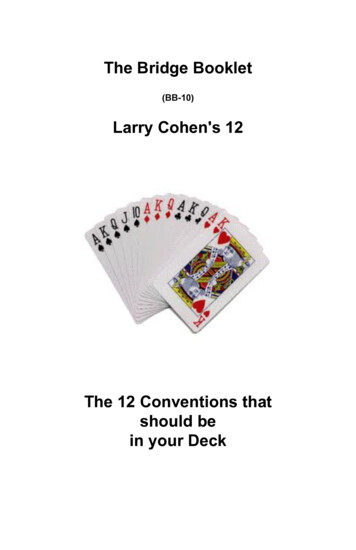
Transcription
The Bridge Booklet(BB-10)Larry Cohen's 12The 12 Conventions thatshould bein your Deck
According to Larry Cohen the 12 conventions that shouldbe in every players deck are:1. Negative Doubles2. Blackwood3. Stayman4. Jacoby Transfers5. 4th Suit Game Force6. Methods vs Opponents NoTrump (DONT)7. Weak Jumps in Competition8. 2NT asks after our Weak-Two Bids9. Unusual NoTrump/Michaels10. New Minor Forcing (Chechback)11. Jacoby 2NT12. Support DoublesThese (and a few more) are covered here.The articles and examples cited here are largey takenfrom the ACBL web site at: www.acbl.org and LarryCohem's web site at www.larryco.com.Other useful sites are:Karen's Bridge dgedepot:bridgedepot.net
IndexStayman . . . . . . . . . . . . . . . . . . . . . . . . . 4Jacoby Transfers . . . . . . . . . . . . . . . . . . . . 5Texas Transfers . . . . . . . . . . . . . . . . . . . . . 6Smolen . . . . . . . . . . . . . . . . . . . . . . . . . 7Drury . . . . . . . . . . . . . . . . . . . . . . . . . . . 8Jacoby 2NT . . . . . . . . . . . . . . . . . . . . . . . 10Michaels/Unusual NT . . . . . . . . . . . . . . . . . . 11Splinter . . . . . . . . . . . . . . . . . . . . . . . . . 15New Minor Forcing . . . . . . . . . . . . . . . . . . . 164th Suit Forcing . . . . . . . . . . . . . . . . . . . . . 20Inverted Minor . . . . . . . . . . . . . . . . . . . . . 22Roman Keycard (1430) . . . . . . . . . . . . . . . . . 24DONT . . . . . . . . . . . . . . . . . . . . . . . . . . 28Modified Ogust . . . . . . . . . . . . . . . . . . . . . 30Cue-Bid Limit Raises . . . . . . . . . . . . . . . . . . 31Help Suit Game Try . . . . . . . . . . . . . . . . . . 33Doubles . . . . . . . . . . . . . . . . . . . . . . . . . 37Takeout . . . . . . . . . . . . . . . . . . . . . . . . 37Negative . . . . . . . . . . . . . . . . . . . . . . . 38Support . . . . . . . . . . . . . . . . . . . . . . . . .39Responsive . . . . . . . . . . . . . . . . . . . . . . 41Maximal . . . . . . . . . . . . . . . . . . . . . . . 43
Stayman(This is used by Responder after a 1NT opening bid)Responses: modern players prefer that the 1NT bidderplay as many of the contracts as possible to keep thestrong hand hidden from the defense. In order to causeopener to bid a suit first, experts use the Staymanconvention and Jacoby Transfers to cause opener tomake the first call in a suit.Stayman: holding 8-9 HCP and one or two 4-card majors,responder bids 2 over 1NT to ask if opener has a4-card major. Without such, opener bids 2 . With two4-card majors, opener bids hearts first. If opener bids themajor in which you hold less than 4 cards, bid 2NT (with10 HCP, bid 3NT). Opener will know you have 4 cardsin the unbid suit.Example:North AJ76 KQ54 AT QJTSouth KT32 A65 Q983 65North opens 1NT and South has enough HCP (8) toinvite game. With four spades, South bids 2 to ask ifNorth has a 4-card major. With four cards in both majors,North bids the lower (2 ). South has only invitationalpoints, and bids 2NT. North knows that South would nothave bid 2 without a 4-card major. If it isn’t hearts, itmust be spades. Since North has 17 HCP, partner’s 8-9should be enough for game most of the time, so Northbids 4 . Note that by bidding 2 , South ensures that ifNorth has a 4-card major, the North hand will be the firstto bid the major and will be declarer.4
Jacoby TransfersAnother useful convention after partner has opened 1NTor 2NT is called the Jacoby Transfer. Here you have amajor suit with 5 cards and wish to have opener bid thesuit so that the strong hand will be hidden if the contractis played in that suit. You bid 2 over 1NT to transfer partner to 2 . You bid 2 over 1NT to transfer partner to 2 .After partner has followed orders and made the transferbid, you have a variety of possible actions depending onthe strength of your hand and the number of cards youhave in the transfer suit. With 0-7 HCP, pass With 8-9 HCP, bid 2NT with 5 cards in the transfersuit and bid 3 of the transfer suit with 6 cards With 10 HCP and 5 cards in the transfer suit, bid3NT. With 10 points and a 6-card suit, bid 4 of thetransfer suit.Examples: Partner has opened 1NT. What is your bidwith each of the following hands?1. JT765 AK5 762. T987 AQ653. A32 43 Q654 A324. 43 QJT765 A3 T82 32 32 J43#1. Bid 2 to transfer opener to 2 ; then bid 2NT to invitegame.#2. Bid 2 to show 8 HCP and one or more 4-cardmajors. If opener shows a 4-card major, bid game in thatsuit. If opener denies a 4-card major by bidding 2 , jumpto 3NT.5
#3. Pass with less than 8 HCP and no 5-card major or6-card minor.#4. Bid 2 to transfer opener to 2 . Then, with 8 HCPand a 6-card suit, invite game and show the 6-card majorby bidding 3 .The principle of bidding game or inviting game is this: Ifyour HCP added to the minimum partner has shownequals 23-24, make an invitational bid; if that numbertotals 25 , make a game bid; if the total is 33 , make aslam bid.Texas TransferThis transfer system in response to a 1NT opener bypartner is similar to Jacoby Transfers in that the transferis made into a major suit. The primary difference is thatthe transfer bid of diamonds to transfer to hearts andhearts to transfer to spades is made at the 4-level. 1NT- 4 transfers to 4 1NT- 4 transfers to 4 The bid at the 4-level announces a 6-card suit (or better)and enough points for partner to play at game but deniesany interest in slam. The bids have the added advantageof getting to game quickly, before LHO can make adefensive bid, either to try and steal the bid or as a suitpreference and lead indicator.If responder has slam interest in either major, the transferis made at the two-level (Jacoby Transfer) and responderthen jumps to game in the appropriate major. Openerthen can evaluate the opening hand in terms of trump fitand strength. If at the upper end of the 1NT range with agood fit in the major, opener is encouraged to bid slam orto make a slam try by bidding 4NT.6
SmolenInstead of using transfers for hands that are 5-4 in themajors, the Smolen Convention uses Stayman (2 ).After partner’s 1NT opening, you bid 2 . If partnerpleasantly surprises you by bidding a major, you’ll simplyjump to four of that major, and partner will declare. If yourpartner doesn’t have a four-card major he wll respond toyour Stayman inquiry with 2 . Now what? Could you stillhave a 5–3 major-suit fit? Is there a way to find out?This is where Smolen helps. You now jump to the threelevel of your shorter major. This Alertable call tellspartner that you have four cards in that major and five inthe other.Consider the following:Opener Q82 A96 K54 AQT7Responder AK653 K874 873 4With this example hand, you’d jump to 3 after opener’s2 rebid. This would tell partner that you have four heartsand five spades. With three-card spade support, hewould bid 3 , and you could raise to 4 or cuebid if youwere interested in slam. Without a three-card spade fit,partner would simply sign off in 3NT. Either way, partner– the 1NT opener – declares.Example auctions:Opener1NT2 (2)4 (4)PassResponder2 (1)3 (3)Pass7
(1) Stayman: do you have a four-card major?(2) No.(3) Smolen: I have five hearts and four spades.(4) I have three hearts and prefer this to 3NT.Opener1NT2 (1)3NT (4)Responder2 (2)3 (3)Pass(1) Stayman: do you have a four card major ?(2) No(3) Smolen: I have five spades and four hearts.(4) I don’t have a fit for spades - we will play NoTrumpTwo-Way Reverse DruryThis is a variation of the Drury convention. It allows apassed hand to show 3- and 4-card limit raises afterpartner opens 1 or 1 . After hearing partner's 1 / inthird or fourth seat:2 Artificial, 10-12 points with exactly 3-card support2 Artificial, 10-12 points with 4 card supportOpener's RebidsAfter opening 1 and hearing a 2 response:2 A sound opening bid (12 points)2 A weak hand (10-12 points)All other bids: Natural, with normal opening values(12 points)After opening 1 and hearing a 2 response:2 A weak hand (10-12 points)All other bids: Natural, with normal opening values(12 points)8
After opening 1 and hearing 2 :2 A sound opening bid2 Natural, 4 hearts, but does not guarantee a fullopening bid2 A weak handAll other bids: Natural, with normal opening values(12 points)After opening 1 and hearing 2 :2 Natural, 4 hearts, but does not guarantee a fullopening bid2 A weak handAll other bids: Natural, with normal opening values(12 points)ExamplesNorth 864 AKT A752 T83WestPassPassAll PassSouth AJ92 QJ987 6 QJ2NorthPass2 (1)EastPassPassSouth1 2 (2)1 Two-Way Reverse Drury, showing exactly 3 heartsand 10-12 points.2 Showing minimum strength. (Playing "normal"Drury, this would show a sound opening bid.)9
North K864 K632 T8 A63WestPassPassPassSouth AJ952 A9 92 KQ65NorthPass2 (1)4 (3)EastPassPassAll PassSouth1 3 (2)1 Two-Way Reverse Drury, showing 4 spades and10-12 points.2 Natural, promising sound opening strength.3 Bidding game with a good club fit.Jacoby 2NTThis convention fills the gap when responder has a limitraise or better. As a Responder bidding a new suit and then supporting openershows 11-12 HCP with 3-card support for opener'ssuit jumping to 3 of openers suit shows 11-12 HCP with4-card support bidding (a Jacoby) 2NT is treated as a game forcewith min 3-card support, perhaps with an interest inslam1 – P – 2NT – P?Openers rebids are: 3-of-a-new-suit shows a singleton or a void in thatsuit10
4-of-a-new-suit shows a good quality 5-card suit 4-of-the-agreed-major shows a minimum handwithout shortness or slam interest Rebidding 3NT (medium hand) shows a soundopening without shortness Rebidding 3-of-the-major (maximum hand) showsslam interest and denies shortnessMichaels Cuebid and Unusual NoTrumpAfter an opponent opens, it's often difficult to describe ahand with two long suits. The auction may get too high(or end too soon) for you to show both, or you may nothave the strength to safely bid either suit. Consider theseproblems if RHO opens:a. RHO opens 1 or 1 and you hold: KQ964 KQ872 52 7b. RHO opens 1 or 1 and you hold: 765 Void K10765 QJ1093c. RHO opens 1 or 1 and you hold: 4 KJ872 AJ10754 5With a. you would overcall 1 and hope to bid heartslater. With b. and c. it may be dangerous to bid at all,especially at the 2-level. Both hands have good playingstrength, but neither can be described with a standardovercall, which tends to show a one-suited hand withmore high-card points.The Michaels Cuebid and Unusual Notrump areconventions that let you show two suits with one bid. Theconvention you use depends on which suit the opponentopens and which suits you have. They are generallyplayed together, as the concepts behind them are similar.11
Michaels Cue-BidThis is a direct cuebid of the opponent's opened suit (1 by RHO, 2 by you) to show 5 -card length in two othersuits. One of your suits is always a major, but the exacttwo you promise depend on the opening bid: Over a minor-suit opening, a Michaels Cuebid(1 -2 or 1 -2 ) shows both majors. Over a major-suit opening, a Michaels Cuebid(1 -2 or 1 -2 ) shows the OTHER major and anunspecified minor.Unusual 2NTThis convention is a direct jump to 2NT over anopponent's opening bid to show the two lowerest-rankingunbid suits. You should have at least 5 cards in each suitfor this bid. The exact suit you promise depend on theopening bid. Over an opening of: 1 , 2NT shows diamonds and hearts. 1 , 2NT shows clubs and hearts. 1 or 1 , 2NT shows both minors.In the example hands, Hand a. is perfect for a MichaelsCuebid. With b. an Unusual 2NT shows both suits withoutpromising great high-card strength. And with c. yourovercall depends on which suit the opponent opened -over 1 , you would bid 2 Michaels to show the othermajor and a minor; over 1 , you would use the Unusual2NT to show the two lower unbid suits.Strength requirementsMichaels Cuebids and Unusual Notrump overcalls areusually preemptive in nature - they show good suits anddistributional values, but don't necessarily promise the12
high-card strength of a regular overcall (the right 7HCP isenough). They can, however, be used with strongerhands where you want to force partner to choose one ofyour suits. Over an opponent's 1 opener, for example,you can bid 2 Michaels with AKQ98 KQJ92 K5 7,and then jump to game in the major partner bids.Finding partner's unknown suitThe one case where you won't know partner's exact twosuits is when he makes a Michaels Cuebid over a 1 or1 opening (showing the other major and an unspecifiedminor). Since you know his major, you can bid it if youhave 3 -card (or 2-card) support. If you can't support hismajor but have at least 3-card length in both minors,you'll want to play in his minor suit. To ask partner whichminor he holds -- and tell him that's your preferred trumpsuit -- bid 2NT. Partner will bid his long minor and youcan then pass, raise or sacrifice.Responding bidsRemember that partner's Michaels Cuebid or 2NTovercall is artificial. If your RHO passes, you cannotpass. For all Unusual 2NT overcalls and most MichaelsCuebids, you'll know the exact two suits partner holds, sobid your longer one. You should almost always bid one ofpartner's suits; don't be tempted to suggest any other suitas trumps unless you have great length and strength in it.The level of your bid depends on your strength and trumpsupport. With a weak-to-intermediate hand, bid at thelowest level available. With a stronger hand, you canjump in one of partner's suits to invite game or jumpdirectly to game.If RHO makes an intervening bid, you should compete ifyou have some strength and support for one of partner'ssuits. Partner is promising 5-5 in his suits, so any 3-card13
holding is good support.If you're not vulnerable and you have a weak hand withstrong support, you may want to sacrifice. Suppose LHOopens 1 , partner overcalls 2 (spades and a minor),and you hold J964 5 A872 J874 . You know theopponents can make at least 4 , so if you're notvulnerable, you should sacrifice right away by jumping to4 . With your long trumps and singleton (and filler inwhatever partner's minor is), a spade contract shouldmake at least 8 or 9 (and maybe 10) tricks.Other usesThese conventions are most commonly used in directseat over an opponent's opening bid, but can apply inother types of auctions, too. If an opening bid is passedaround to you, you can balance with a Michaels Cuebidor Unusual 2NT. For example, after 1 by LHO-PassPass, 2 by you would be Michaels, showing bothmajors. After 1 -Pass-Pass, a bid of 2NT is Unusual,showing both minors.You can also play that any "unusual" notrump overcall(even if it's not a jump) is the Unusual Notrump. Forexample, after 1 by LHO-Pass-2 , 2NT by you showsboth minors (similarly, 1 -Pass-2 -3 is Michaels,showing spades and a minor).Notrump overcalls at higher levels also convey thismeaning: 1 by LHO-Pass-3 -3NT by you shows clubsand hearts. 1 -Pass-4 -4NT shows both minors. Thehigher the level, the stronger and more distributional yourhand should be for your bid.14
Splinter BidsSplinter bids offer a method to make a slam inquiry belowthe four-level of partner’s suit. A splinter bid overpartner’s 1 /1 major shows a void or singleton in thesuit bid, four or more trumps, and an opening hand. Thebid is made as a double jump shift into the splinter suit. Ifthe singleton is an honor card, the hand should holdopening count not counting the singleton honor. If partnerhas no wasted values in the splinter suit–or a full openernot counting any wasted values–a slam can usually bemade with a combined 26 HCP because all high cardsare”working”–complementing each other as they are all inthe same three suits.Bidding:North1 ?EastPSouth4 WestPWith a minimum opening and wasted values in clubs,opener will bid 4 to reject the slam try–and responderwith extras can still make a slam try by bidding past 4 .If opener makes any bid other than four of the agreedmajor, the slam try has been accepted. Opener andresponder may start a cue-bidding sequence to showaces, kings, or first-round controls–or may start aBlackwood or Roman Key Card inquiry.Possible continuation of the bidding:North1 4 *6 ***EastSouthP4 P5 **All passWestPP* I accept the slam try, and I hold the ace of heartsbut not the ace of diamonds15
**I hold the ace of diamonds but not the ace ofspades or a void in clubs***6 looks makeableWith a good “read” on the hand opener bids 6 withexpectations of making the bid. Here might berepresentative hands:Opener AQJ32 A2 K98 43Responder K987 KQ43 A54 2Total HCP in the combined hands: 26; making slam–priceless.Splinter bids can also be made over partner’s minor suitopening with a double jump shift into a new suit. Sincethe 1 /1 minor bid can be made with a three-card suit,responder should hold 5 cards in partner’s suit.New Minor ForcingThis convention is used when the OPENER rebids 1NTor 2NT. Responder bids the new minor as an artificialway to ask about (or "check back" on) the majors.Example Auctions: In each of these auctions,responder's second bid is new minor forcing. Theresponder is asking the opener about the majors(typically looking for 3-card support).1.OPENER1 1NTRESPONDER1 2 16
2.OPENER1 1NTRESPONDER1 2 3.OPENER1 2NTRESPONDER1 3 New minor is used only by the responder and always ashis second bid of the auction. It promises at leastinvitational (10 - 11) strength (after a 1NT rebid) andsome doubt about what the final contract should be. Inmost cases, the responder will have 5 cards in his majorand be trying to decide if the hand should be played inhis suit or in notrump.These Responder hands match the auctions above:1. 1 -1 -1NT-2 :2. 1 -1 -1NT-2 :3. 1 -1 -2NT-3 : KQT AQJ73 Q32 32 AQT85 KJ75 K2 54 KJ854 5 Q76 7652In each hand above, the responder is hoping the openercan show 3-card support for his major. When the newminor is bid, the opener must ALERT. If the opponentsask, he can explain: "My partner's bid is artificial andforcing for one round. He is asking me about my majors."The opener now should show 3-card support if he has it(with 4-card support he would have raised on theprevious round). If the opener doesn't have 3-cardsupport, his next obligation is to show 4-cards in theother major. If he has neither of the above, he makes thecheapest bid he can (over clubs he bids diamonds; overdiamonds he bids notrump).17
Meanings for Opener:1.OPENER RESPONDER1 1 1NT2 ?2 3-card heart support2 4 spades, but not 3-card heart support(unlikely since no 1 bid)2 None of the above2.OPENER RESPONDER1 1 2NT3 ?3 No major3 3-card heart support3 4 spades (not 3 hearts)*Note: If you play this convention, make sure partner isplaying it the same way as you. I suggest it be played aswritten here, but some people play that on Opener's 3rdbid he bids his cheapest major (up-the-line). (In otherwords, he might show 4 hearts before showing 3-cardspade support.)Examples for Opener:1 KQ2 J432 AQ2 Q76OPENER1 1NT?RESPONDER1 2 Bid 2 (unless you are playing that you showhearts first with 4 hearts and 3 spades)18
2 AQ3 KJ KQT52 K43OPENER1 2NT?RESPONDER1 3 Bid 3 (Denying 3 and denying 4 )3 AQ AJ54 AT43 KT3OPENER1 2NT?RESPONDER1 3 Bid 3 Follow-ups (Responder's 3rd Bid): a bid of 3NT is "Choice of games," promising 5cards in his major. a bid of 4 of the major is to play. a re-raise is invitational.Examples:1 KJ954 AJ3 K54 J 2OPENER1 1NT2 RESPONDER1 2 ?Bid 3NT—This means you have 5 spades and youare offering a choice between 3NT and 4 (partner knows you would have bid 3NT directlywithout 5 spades).19
2 3 KQJ95 AJT4 Q32OPENER1 1NT2 RESPONDER1 2 ?Bid 4 – You are not interested in offering achoice with this shapely hand.3 A9765 AQ32 43 J 7OPENER1 1NT2 RESPONDER1 2 ?Bid 3 to invite (or 4 if your partner really playsthem well).Note: "New Minor" should NOT be on in competition (ofany kind). Decide if you wish to use it by a Passed Hand(No strong feelings--just make sure to discuss).Fourth Suit ForcingFourth Suit Forcing is used by the responder to establisha game force. So, after, say, 1 -1 -1 , a bid of 2 is the4th suit. Any time the auction starts: 1 grape-1 apple, andopener bids a 3rd suit, responder can bid the 4th suit(artificially) to set up a game force.I recommend that the 4th suit is 100% forcing to Game.Example:After 1 -1 -2 , responder holds: AQ432 4 Q32 AKQ2. He bids 2 to set up a game force. Thebids says absolutely nothing about the suit. It could be432, it could be AKQ. It could be a singleton, it could be afive-card suit. If opener has the 4th suit stopped, he will20
usually bid notrump. Both players assume the 4th suit isunstopped until either player bids notrump.Opener's 3rd bid (after 4th suit forcing is used)The opener bids naturally. He should have a stopper inthe 4th suit in order to bid notrump. He is allowed to takea preference to responder's first suit with honordoubleton.Example hands for opener after: 1 -1 -2 -2 : 53 K2 KQJ87 A1076Bid 2NT (hearts stopped) Q5 54 KQJ87 AJ74Bid 2 (this does not guarantee 3-card support) 53 Q AK765 KQ1065Bid 3 to show 5-5Opener can jump raise responder's first suit with threecards and a maximum, such as: KQ107 K32 AQJ43 2 (after 1 -1 -1 -2 , jump to 3 ).Notes: Only the responder can use 4th suit forcing (neverthe opener). It has to be the 4th bid of the auction. Fourth suit forcing is typically not used after a 2/1GF response. The 4th suit would be natural in thatcase (1 -2 -2 -3 clubs). Fourth-Suit is NATURAL and non-forcing by apassed hand (P-P-1 -P-1 -P-2 -P-2 5-5 orlonger in / ). If the opponents have made an earlydouble, 4th suit forcing is still on. If they overcall, it isoff. Fourth Suit forcing is alertable. Fourth Suit forcing is not used after a 1NT rebid byopener (new minor forcing is used).21
Inverted MinorThe popular Inverted Minors convention reverses (or"inverts") the standard meaning of the strength of minorsuit raises.In "Standard," a raise from 1 to 2 (or 1 to 2 ) shows6-9, while a raise to 3-of-the-minor shows 10-12 (limit).If playing "Inverted," the raise from 1 to 2 (or 1 to2 ) is 10 and the raise from 1 to 3 (or 1 to 3 ) isweak (typically less than 7). There is a gap for hands ofabout 8-9 points (too strong to raise to 3, but not strongenough to raise to 2).[Note: In some modern versions ofthis convention the raise to 3 is used as a "Mixed" raiseto show 6-9--make sure you and your partner know if youare playing the jump as "weak" or "mixed."]In no case should a minor be raised if responder has a4-card major.Here is an example of 1 -2 : A2 K32 QJ10876 J2Here is an example (nobody vul) of 1 -3 : 2 654 875 KJ8765When playing this convention, here are the discussionpoints:1. Is it on by a Passed Hand? I'd say: YES.2. Is it on after a Double or Overcall? I'd say: NO.3. How high is the partnership forced after the raise from1 to 2? I recommend that you can stop in a partscoreif either player's next bid is 2NT or 3-of-the-minor.Otherwise, it is Game Forcing. (Example of a NFauction: 1 -2 -2NT-3 )4. How light can the raise from 1 to 3 be? I suggestrelying on the vulnerability. At favorable, it can be22
something like Jxxxxx and out. At unfavorable, itwould be much sounder, maybe up to AQ10xxx andout. (See the note above about the option to play thejump raise as Mixed).5. How many cards to raise? In clubs, usually five ormore. In diamonds, five are also the normalrequirement, but it can occasionally be done with four(since a one-diamond opener is usually four-pluscards).6. What does it mean if opener bids 2-of-a-Major afteran inverted raise (1-2-2)? I recommend that it showsa stopper/concentration (it is pointless to show a 4card major, since responder should never raise aminor with a 4-card major). After this show ofconcentration, if responder bids 2NT or 3-of-theminor, it can be passed.There are more bells and whistles which can be added,but in the KISS style, the above is sufficient to useInverted Minors.23
Roman Key Card Blackwood (1430)This is a variation of the Blackwood convention. It is usedwhen the partnership has agreed to a trump suit and isinterested in slam. A 4NT bid asks partner how many"key cards" he holds. A key card is any ace or the trumpsuit king.There are two versions of RKC: 0314 and 1430("Fourteen-Thirty"), which refer to the step responsesbelow.Responses to 4NTBid5 5 5 5 MeaningShows 1 or 4 key cards.Shows 0 or 3 key cards.Shows 2 or 5 key cards without the queenof trumps.Shows 2 or 5 key cards with the queen oftrumps.The 4NT bidder can usually (!) determine if responderhas 1/4, 0/3, or 2/5 key cards.Void-showing responsesIf responder has a void, he can make one of the followingbids to describe his hand.Bids5NT6 6 MeaningShows an even # of key cards and a voidsomewhere.Shows an odd # of key cards and: A club void if clubs aren't trumps, or A void in any other suit if clubs aretrumpsShows an odd # of key cards and:24
6 A diamond void if hearts or spades aretrumps, or A void in hearts or spades, if diamondsare trumpsShows an odd # of key cards and: A heart void if spades are trumps, or A spade void if hearts are trumpsAsking for Kings (5NT)A 5NT rebid asks partner for kings. It is a grand slam try,and should only be bid if the partnership holds all 5 keycards and the queen of trumps.There are two ways to play 5NT:1 To ask partner to bid his cheapest (non-trump)king.2 To ask partner how many kings he holds (standardBlackwood responses):6 shows 0 kings.6 shows 1 king.6 shows 2 kings.6 shows 3 kings.An example auction playing RKCB with the 5NT"cheapest" king-ask:Opener K AQT754 A5 AQ54Responder A65 K632 K6 J93225
Opener1 4NT (1)5NT (3)6 (5)12345Responder3 5 (2)6 (4)RKCB for hearts.2 key cards without the Q .Asking for partner's cheapest king.Showing the K.Signing off because of the missing K.Asking for the Trump QueenSometimes the 4NT bidder wants to know the location ofthe trump queen, but hears a 5 or 5 reply. Theseresponses don't indicate whether responder holds thequeen of trumps. So, the 4NT bidder can bid thecheapest non-trump suit to ask this question. Theresponses to the queen-ask are as follows.Responses toMeaningthe Queen AskBidding the trump suit No trump queen5NTThe trump queen without anyside-suit kingsBidding anyThe trump Queen ANDnon-trump suitthe king of that suit26
An example auction playing RKCB 1430 with a queenask:OpenerResponder AJT75 K93 AKT Q3 AKT2 J8 5 KQ7642Opener1 3 4NT (1)5 (3)Pass1234Responder2 3 5 (2)5 (4)RKCB for spades.1 key card.Asking for the Q.Denies the Q.RKCB In CompetitionROPI when the opponents double 4NT. Redouble shows0, 3 or 5 keycards while Pass shows 1 or 4 keycards.There are a number of ways to show key cards if 4NT isovercalled. One way is called DOPI, which stands for"Double 0 (or 3 or 5) key cards, Pass 1 (or 4)." Thecheapest available bid shows two key cards, the secondcheapest bid shows three key cards, and the thirdcheapest bid shows four.Another method of showing key cards is DEPO, whichstands for "Double Even number of key cards, Pass Odd number of key cards."27
DONTDisturbing Opponents' No Trump is a conventionaldefense used after an opposing 1NT opening. Itsacrifices the natural penalty double in order to show allpossible one- and two-suited hands.After an opposing 1NT:Dbl: Any one suit (5 cards), relays to 2 2 : Clubs and a higher suit (At least 5-4 in the twosuits)2 : Diamonds and a higher suit (at least 5-4)2 : Hearts and spades (at least 5-4)2 : 5 spades, (weaker than a double followed by a2 rebid)After hearing a double, partner is expected to bid 2 ,which is completely artificial. (He may, however, bypassthe 2 relay and bid a very strong 6-card suit of his own.)The 2 bid allows doubler to then show his suit: hepasses with clubs and bids his suit otherwise. A jump bidby either player is strong and invitational, but not forcing.A raise of doubler's suit is also invitational but not forcing.After hearing a 2 or 2 overcall, partner usually passeswith support for the bid suit; otherwise, he can bid thenext-highest suit to try correcting the contract. Forexample:Opp1 Overcaller1NT 2 !Opp2 PartnerPass 2 !The 2 bid denies support for clubs and asks forovercaller's other suit. With diamonds, overcaller passes;with a major, overcaller bids it.A 2NT response by partner at any time is strong andforcing for one round. Depending on partnership28
agreement, it can be an intricate shape-asking bid, but ifa simpler version of DONT is preferred, it can just showsupport for overcaller's suit and ask him to bid more withextra values.When to use DONTDONT is all about Disturbing the Opponents NoTrumpopener. To determine if it is OK to overcall a 1NT bid usethe following guideline: count the number of cards you have in your twolongest suits subtract the number of losers if the answer is 2 ot higher, bid something if the answer is 1 or less, PassCounting Losers: consider the hand AK754 KJ531 loser (missing the Q)2 losers (missing AQ)2 losers (missing AK)1 loser (missing A) Q84 6Now look at the following:1. K75 AQ865 K43 762. K7532 K8654 43 7In hand 1, there are 8 cards in the two long suits butthere are 7 losers (two each in Spades, Diamonds andClubs). You should pass despite having 12 HCP and a5-card major since:Length (8) - Losers (7) 129
In hand 2, there are 10 cards in the 2 long suits and 7losers (2 each in Spades, Diamonds and CLubs). Herehowever you should bid since:Length (10) - Losers (7) 3Pay attention to vulnerability when using DONT butremember, Distribution is the KEYModified OgustWhen partner opens a Weak-2, add your HCP to yourtrump holding. If the total is 17 or more you should beinvestigating game through the use of the Ogustconvention.The Ogust convention allows the responder to bid 2NT,a forcing bid, to allow opener, by a system of Relaybids, to descr
#3. Pass with less than 8 HCP and no 5-card major or 6-card minor. #4. Bid 2 to transfer opener to 2 .Then, with 8 HCP and a 6-card suit, invite game and show the 6-card major
